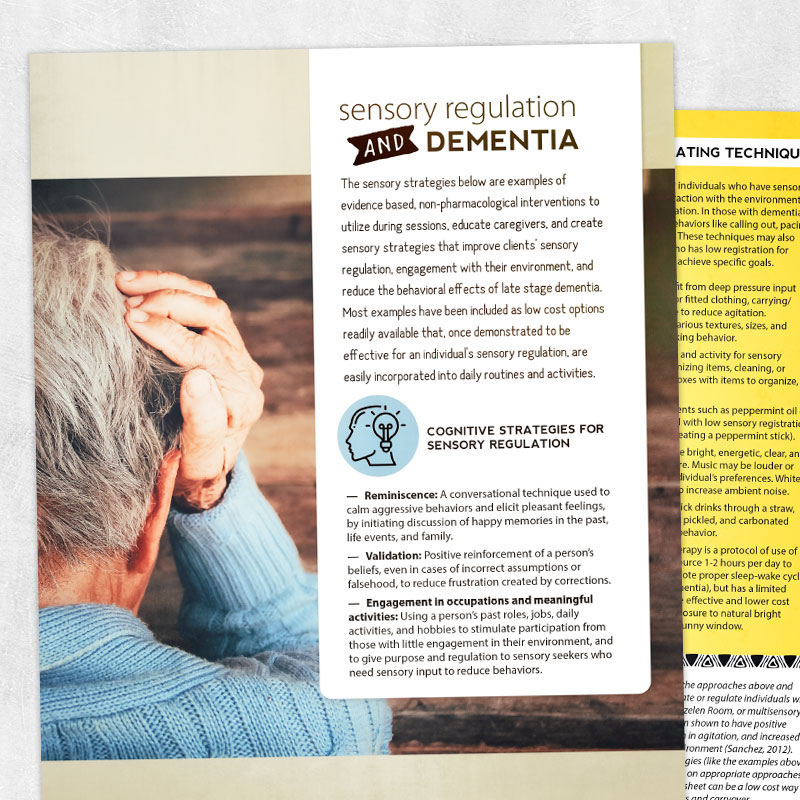Sensory Regulation Occupational Therapy
Occupational therapy sensory processing and self-regulation are crucial aspects of promoting overall well-being and functioning in individuals. By understanding and addressing sensory difficulties, occupational therapy practitioners can help individuals develop the necessary skills to regulate their sensory responses and participate fully in their daily activities.
Sensory Processing and Regulation
Sensory processing refers to the way our nervous system receives and interprets sensory information from the environment. It involves the integration of various sensory inputs, such as touch, sight, sound, taste, and movement. For some individuals, sensory processing can be challenging, leading to difficulties in regulating their responses to sensory stimuli.

Figure 1: Occupational Therapy Sensory Processing
Occupational therapists play a vital role in helping individuals overcome sensory processing difficulties and develop effective self-regulation strategies. By working closely with individuals, occupational therapists can provide targeted interventions and create sensory-rich environments to promote improved regulation.
The Role of Occupational Therapy in Sensory Self-Regulation
Occupational therapy practitioners utilize evidence-based techniques and interventions to address sensory processing challenges and promote self-regulation in individuals. These interventions aim to help individuals develop the necessary skills to effectively process sensory information and respond appropriately in various environments.

Figure 2: Pin on OT
Benefits of Occupational Therapy Sensory Processing Interventions
Occupational therapy interventions focusing on sensory processing and self-regulation have shown remarkable benefits in individuals across different age groups and conditions. Some of the key benefits include:
- Improved Attention and Focus: By addressing sensory challenges and promoting self-regulation, occupational therapy interventions can help individuals enhance their attention and focus in various settings.
- Enhanced Emotional Regulation: Difficulties with sensory processing can impact emotional regulation. Occupational therapy interventions can provide individuals with coping strategies and tools to manage emotional responses effectively.
- Better Social Participation: Sensory processing challenges can affect an individual's ability to participate in social interactions. Occupational therapy interventions can support individuals in developing the necessary social skills and behaviors for successful participation.
FAQs
1. What is sensory processing disorder (SPD)?
Sensory processing disorder (SPD) is a condition where individuals have difficulties processing and responding appropriately to sensory stimuli. It can impact various areas of daily functioning, including self-regulation, social participation, and attention.
2. How can occupational therapy help with sensory processing difficulties?
Occupational therapy interventions focus on addressing sensory processing difficulties and promoting self-regulation. Occupational therapists utilize a variety of techniques, such as sensory integration therapy, environmental modifications, and individualized strategies, to help individuals overcome their challenges and participate fully in their daily activities.
3. Who can benefit from occupational therapy sensory processing interventions?
Occupational therapy sensory processing interventions can benefit individuals of all age groups who experience challenges with sensory processing and self-regulation. This includes children with autism spectrum disorder, individuals with attention deficit hyperactivity disorder (ADHD), and those with sensory processing disorder (SPD).
Overall, occupational therapy practitioners play a critical role in addressing sensory processing challenges and promoting self-regulation. By implementing effective interventions and strategies, individuals can experience improved attention, emotional regulation, and social participation, leading to enhanced overall well-being and functioning.
Pin On Special Education Behavior Management
 Image Source : www.pinterest.ca
Image Source : www.pinterest.ca Pin On OT
 Image Source : www.pinterest.co.uk
Image Source : www.pinterest.co.uk Sensory Regulation And Dementia – Printable Handouts For Speech
 Image Source : therapyinsights.com
Image Source : therapyinsights.com 91 Sensory Regulation Ideas | Occupational Therapy Activities, Child
 Image Source : www.pinterest.com
Image Source : www.pinterest.com sensory occupational
Self Regulation: Sensory Strategies Starter Kit (Printable PDF
 Image Source : www.pinterest.co.uk
Image Source : www.pinterest.co.uk Pin On S-B OT: Self-Regulation (+ ADHD & ASD)
 Image Source : www.pinterest.com
Image Source : www.pinterest.com sensory regulation disorder processing occupational adhd
OCCUPATIONAL THERAPY SENSORY PROCESSING / SELF REGULATION BUNDLE
 Image Source : www.pinterest.com
Image Source : www.pinterest.com Poster Gallery | Sensory Integration Therapy, Sensory Integration
 Image Source : www.pinterest.com
Image Source : www.pinterest.com occupational sensorische sensorisch integratie processing dieet delay developmental adhd
Self regulation: sensory strategies starter kit (printable pdf. Sensory regulation and dementia – printable handouts for speech. Pin on s-b ot: self-regulation (+ adhd & asd). Pin on ot. 91 sensory regulation ideas